Create and manage snapshot/schedule
Create and manage snapshot
You can create a snapshot from the current state of a volume.
If you have expanded a volume, a full backup must be performed even if snapshots were created previously. Incremental backups may fail or result in unusable snapshots.
Create snapshot from selected volume
-
Go to KakaoCloud console > Beyond Compute Service > Virtual Machine.
-
Select the Volume menu, select the [More] icon next to the target volume, and select Create Snapshot.
-
In the Create snapshot popup, enter the necessary information and select [Create].
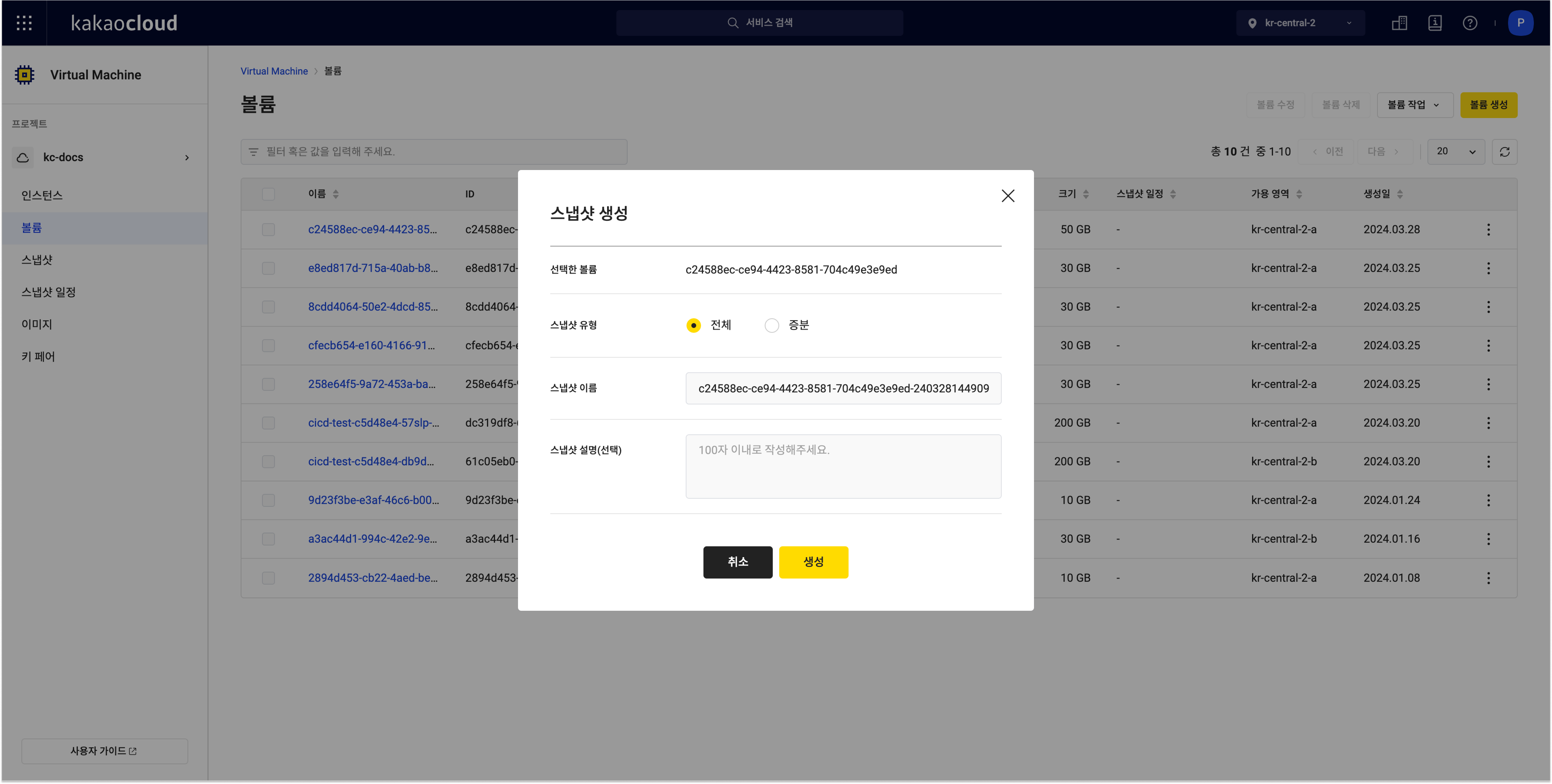 Create Snapshot
Create SnapshotField Description Selected Volume Volume to create the snapshot from Snapshot Type Snapshot method:
- Full: Backs up all data regardless of changes. For example, a full backup of a 50GB volume will create a 50GB snapshot.
- Incremental: Backs up only data changed since the last backup. For example, if 1GB has changed since the last backup, a 1GB snapshot will be created.
- Note: Requires one initial full backup before incremental backups.Snapshot Name Auto-filled from volume name but can be edited manually Snapshot Description (Optional) Description of the snapshot
Create snapshot from snapshot tab
- Go to KakaoCloud console > Beyond Compute Service > Virtual Machine.
- Go to the Snapshot tab and select Create Snapshot on the upper right.
- Enter the required information in the popup and select [Create].
Even if a full backup exists through a snapshot schedule, the first manually created snapshot must be a full backup.
View snapshot list
You can view all owned snapshots and their basic information.
-
Go to KakaoCloud console > Beyond Compute Service > Virtual Machine.
-
Check the snapshot list under the Snapshot tab.
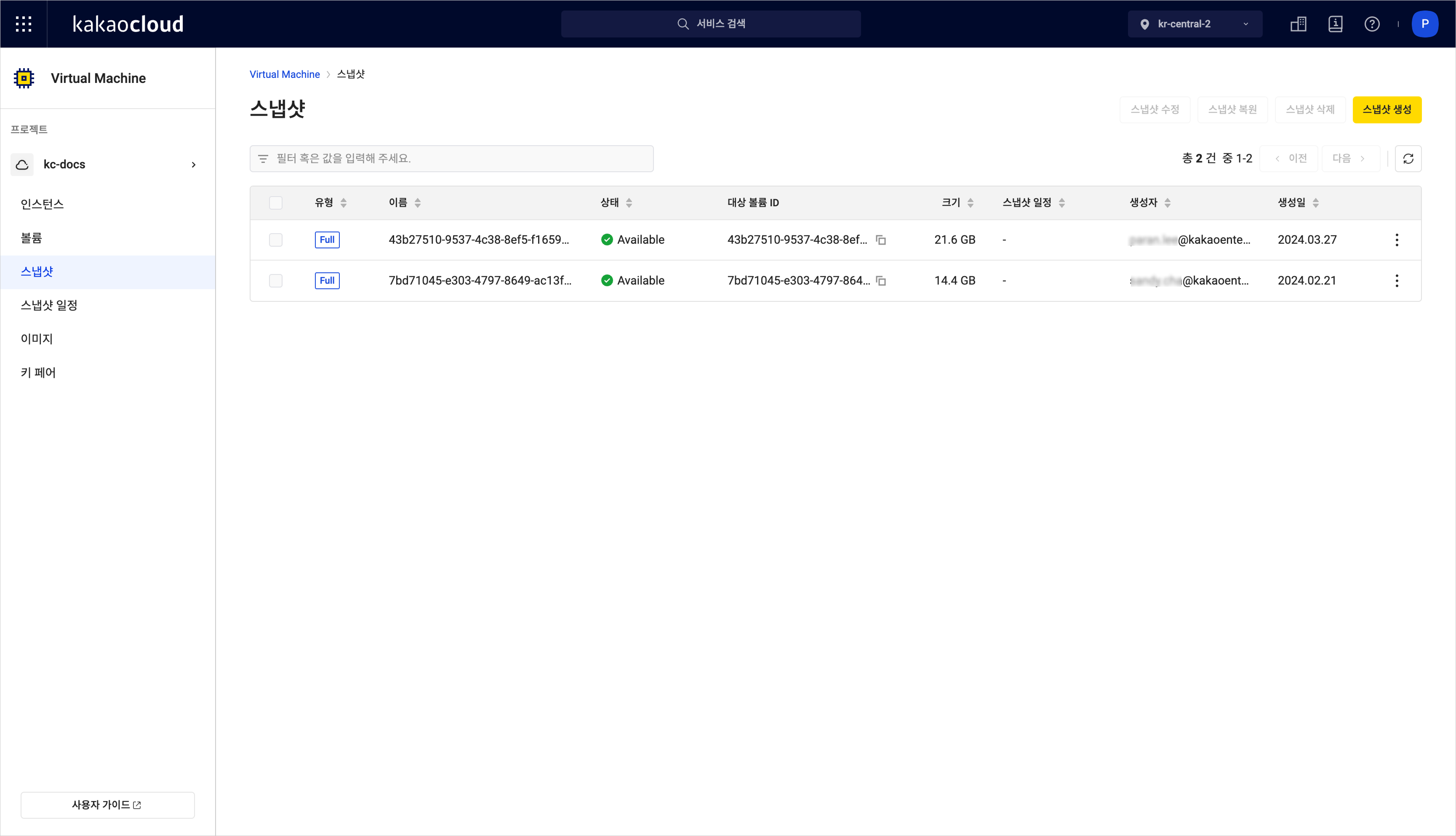
Field Description Type Type of snapshot:
-Full: Full backup
-Incremental: Incremental backupName Name of the snapshot Status Snapshot status:
-Creating
-Available
-Restoring
-Deleting
-ErrorVolume ID ID of the volume the snapshot was taken from Size Snapshot size Snapshot Schedule Manually or automatically generated snapshot name Created By User who created the snapshot Created At Time of creation (hover to see time elapsed) More Available actions:
- Edit
- Restore
- Delete
Restore volume from snapshot tab
You can restore a volume from a selected snapshot.
- Go to KakaoCloud console > Beyond Compute Service > Virtual Machine.
- In the Snapshot tab, select [More] next to the target snapshot and select Restore Snapshot.
- In the popup, select [Restore Snapshot].
Restore from volume tab
- Go to the Volume tab and select the volume that holds the target snapshot.
- In the volume detail page, go to the Snapshot section and select [More] > Restore Snapshot.
- Select [Restore Snapshot] in the popup.
Delete snapshot
You can delete snapshots that are no longer needed.
- Only the latest incremental snapshot can be deleted among multiple incrementals.
- If any incremental snapshots exist, the full snapshot cannot be deleted.
Deleted snapshots cannot be recovered.
- Go to the Snapshot tab.
- Select [More] > Delete Snapshot next to the snapshot to remove.
- Enter the snapshot name and confirm deletion.
Create and manage snapshot schedule
You can configure automatic creation and deletion of snapshots at a set interval for your volumes in the Virtual Machine service.
Create snapshot schedule
You can create a new snapshot schedule.
-
Go to the KakaoCloud console > Beyond Compute Service > Virtual Machine.
-
Select the Snapshot Schedule tab and select the Create Snapshot Schedule button at the top right.
-
In the Create Snapshot Schedule popup, enter the required information and select [Create].
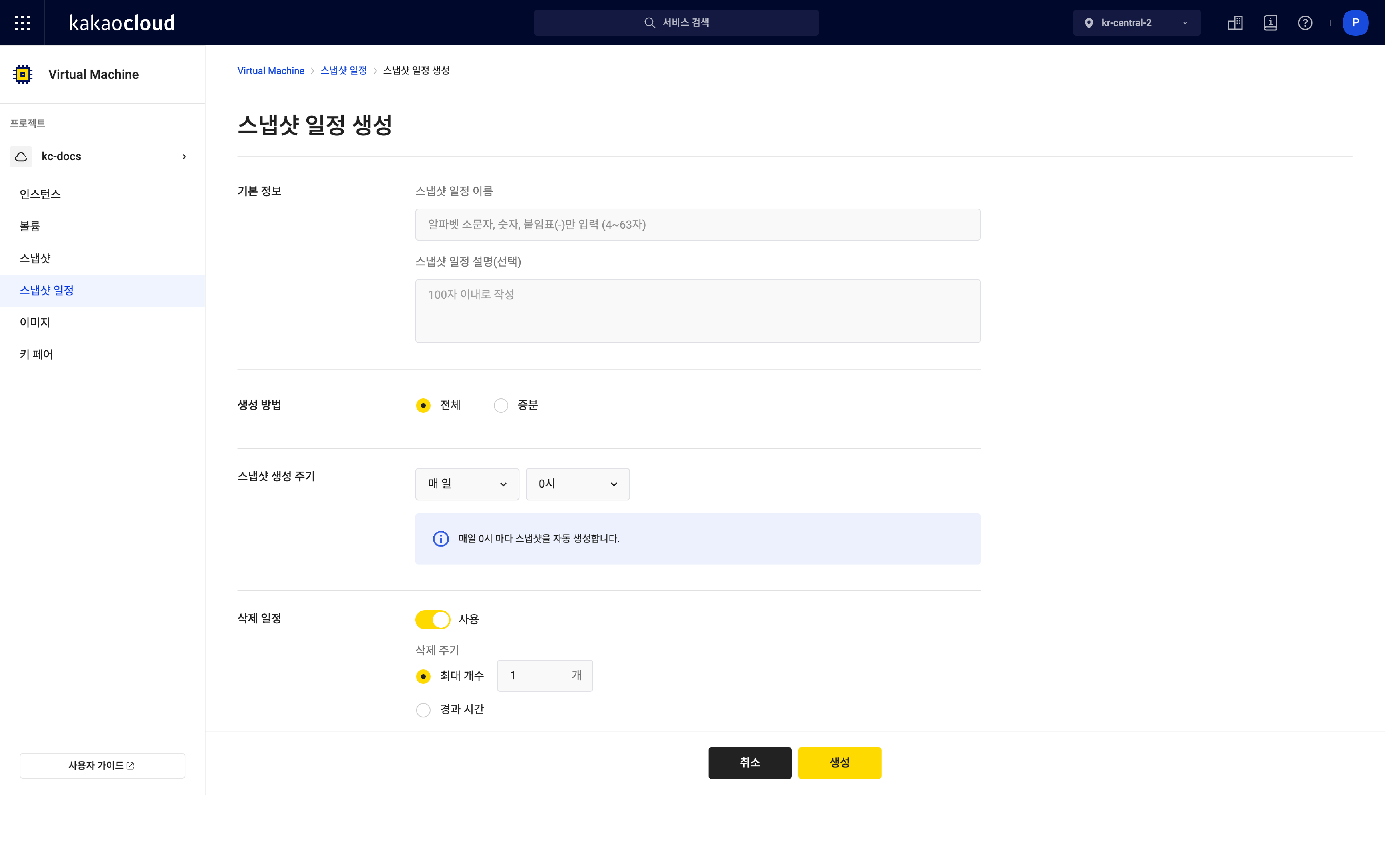 Create snapshot schedule
Create snapshot scheduleItem Sub-item Description Basic info Snapshot schedule name Enter a name for the snapshot schedule Description (Optional) Enter a description for the snapshot schedule Backup type Full Create a full backup at each interval. This copies the entire volume regardless of changes. Incremental Create an incremental backup at each interval. Only changed data since the last backup is copied.
Requires one full backup to be completed firstCreation interval - Set how often to automatically create snapshots Deletion schedule - Snapshots created by the schedule will be deleted after the specified retention period or when exceeding the max count.
View snapshot schedule list
You can check the list of configured snapshot schedules and their basic information.
-
Go to the KakaoCloud console > Beyond Compute Service > Virtual Machine.
-
In the Snapshot Schedule menu, check the list of active snapshot schedules. You can also filter by schedule name or deletion policy.
 Snapshot schedule list
Snapshot schedule listField Description Name Name defined by the user for the schedule Description Schedule description Frequency The interval at which snapshots are created automatically Deletion policy Deletion method and retention period for snapshots created by the schedule Attached volumes Volumes attached to the schedule Created at Date and time when the schedule was created (hover to view more details) More options Available actions: Edit, Attach Volume, Detach Volume, Delete
Attach volume to snapshot schedule
You can attach a running volume to an existing snapshot schedule.
- Go to the KakaoCloud console > Beyond Compute Service > Virtual Machine.
- In the Snapshot Schedule menu, select the [More Options] icon of the desired schedule > Attach Volume.
- In the popup, select the volume to attach and select [Save].
Detach volume from snapshot schedule
You can detach a volume from a snapshot schedule.
- Go to the KakaoCloud console > Beyond Compute Service > Virtual Machine.
- In the Snapshot Schedule menu, select the [More Options] icon of the desired schedule > Detach Volume.
- In the popup, select the volume to detach and select [Detach].
Delete snapshot schedule
You can delete snapshot schedules that are no longer in use.
- Go to the KakaoCloud console > Beyond Compute Service > Virtual Machine.
- In the Snapshot schedule menu, select the [More Options] icon of the schedule > Delete snapshot schedule.
- In the popup, enter the name of the schedule and select [Delete].
Restore data using snapshot
You can restore instance data using volumes created from snapshots.
Restore data by creating new instance
This method restores data by creating a new instance, attaching a volume, and restoring data.
- Restoring data using snapshots is useful when the instance is unbootable or inaccessible via SSH or RDP due to misconfiguration.
- This guide describes how to recover only the backed-up data, not restoring the root volume that contains the OS.
Step 1. Create snapshot of the instance to be restored (Optional)
If a snapshot already exists, you may skip this step.
- Stop the instance that needs to be restored. Wait until its status becomes
Stopped. - Refer to the Create and manage snapshot guide to create a snapshot of the volume storing the data.
Step 2. Create volume from snapshot with data to be restored (Optional)
If the volume has already been created, you may skip this step. For creating a volume from a snapshot, refer to the Restore volume from snapshot tab guide.
Step 3. Create a new instance to restore data
Refer to the Create instance guide to create a new instance with the same type and volume size as the original.
Step 4. Attach volume to the new instance
Refer to the Attach volume guide to attach the volume created in Step 2 to the new instance.
Step 5. Mount the attached volume from the instance
- Linux
- Windows
-
Refer to the Connect to Linux instance document to connect to the newly created Linux instance.
-
Check the attached volume:
Check device connectionlsblkResultNAME MAJ:MIN RM SIZE RO TYPE MOUNTPOINTS
vda 253:0 0 10G 0 disk
├─vda1 253:1 0 9G 0 part /
├─vda14 253:14 0 4M 0 part
├─vda15 253:15 0 106M 0 part /boot/efi
└─vda16 259:0 0 913M 0 part /boot
vdb 253:16 0 10G 0 disk
├─vdb1 253:17 0 9G 0 part
├─vdb14 253:30 0 4M 0 part
├─vdb15 253:31 0 106M 0 part
└─vdb16 259:1 0 913M 0 part -
Check the file system type of the attached volume:
Use the
file -scommand to determine the file system type. Below are sample results for two different file systems:Check file system typesudo file -s /dev/vdbResult(ext4)
/dev/vdb: Linux rev 1.0 ext4 filesystem data, UUID=a69a34bb-e2fd-4e61-bf93-d462c4438730 (extents) (64bit) (large files) (huge files)
(xfs)
/dev/vdb: SGI XFS filesystem data (blksz 4096, inosz 512, v2 dirs) -
Verify the integrity of the volume data. Use the command appropriate for your file system:
- Check data integrity (ext4)
- Check data integrity (xfs)
Check data integrity (ext4)sudo fsck -n /dev/vdbResultfsck from util-linux 2.39.3
e2fsck 1.47.0 (5-Feb-2023)
/dev/vdb: clean, 11/655360 files, 66753/2621440 blocksCheck data integrity (xfs)sudo xfs_repair -n /dev/vdbResultPhase 1 - find and verify superblock...
Phase 2 - using internal log
- zero log...
- scan filesystem freespace and inode maps...
- found root inode chunk
...
Phase 7 - verify link counts...
No modify flag set, skipping filesystem flush and exiting. -
Create a directory to mount the attached volume:
Create mount directorysudo mkdir -p /mnt/restore -
Mount the volume to the created directory in read-only mode, since it contains recovery data:
Mount volume (read-only, ext4)sudo mount -o ro -t ext4 /dev/vdb /mnt/restoreMount volume (read-only, xfs)sudo mount -o ro -t xfs /dev/vdb /mnt/restore -
Verify that the volume was mounted properly:
Verify mountfindmnt /mnt/restoreResultTARGET SOURCE FSTYPE OPTIONS
/mnt/restore /dev/vdb ext4 ro,relatime
Step 6. Restore necessary data from the mounted volume
-
Create a directory to restore data to.
In this document,/path/to/restoreis used as an example path:Create restore directorysudo mkdir -p /path/to/restore/ -
Use the
rsynccommand to copy the data from/mnt/restore/to the restore path.
Note that using the--checksumoption may significantly increase processing time for large data sets.Copy datasudo rsync -avh --checksum /mnt/restore/ /path/to/restore/Resultsending incremental file list
backup-data-1
backup-data-2
sent 2.15G bytes received 55 bytes 330.46M bytes/sec
total size is 2.15G speedup is 1.00 -
Confirm that the data was successfully restored:
Verify restored datals -alh /path/to/restore/Resulttotal 2.1G
drwxr-xr-x 3 root root 4.0K Dec 10 07:24 .
drwxr-xr-x 3 root root 4.0K Dec 10 07:55 ..
-rw-r--r-- 1 root root 1.0G Dec 10 07:57 backup-data-1
-rw-r--r-- 1 root root 1.0G Dec 10 07:57 backup-data-2
Step 7. Detach the connected volume
-
After copying the data, unmount the volume:
Unmount volumesudo umount /mnt/restore -
Follow the steps in the Detach volume document to detach the restored volume from the console.
You must detach the restored volume from the console after recovery is complete.
Leaving the volume connected can result in data corruption, resource waste, or system conflicts.
-
Refer to the Connect to Windows instance document to connect to the newly created Windows instance with the volume attached.
-
Check the attached volume:
- Open the Run dialog by pressing WIN + R.
- Enter
diskmgmt.mscand press Enter to open Disk Management. - Locate the attached volume disk in Disk Management.
- Since the volume contains the operating system, its partition structure will resemble that of the OS volume mounted on the C: drive.
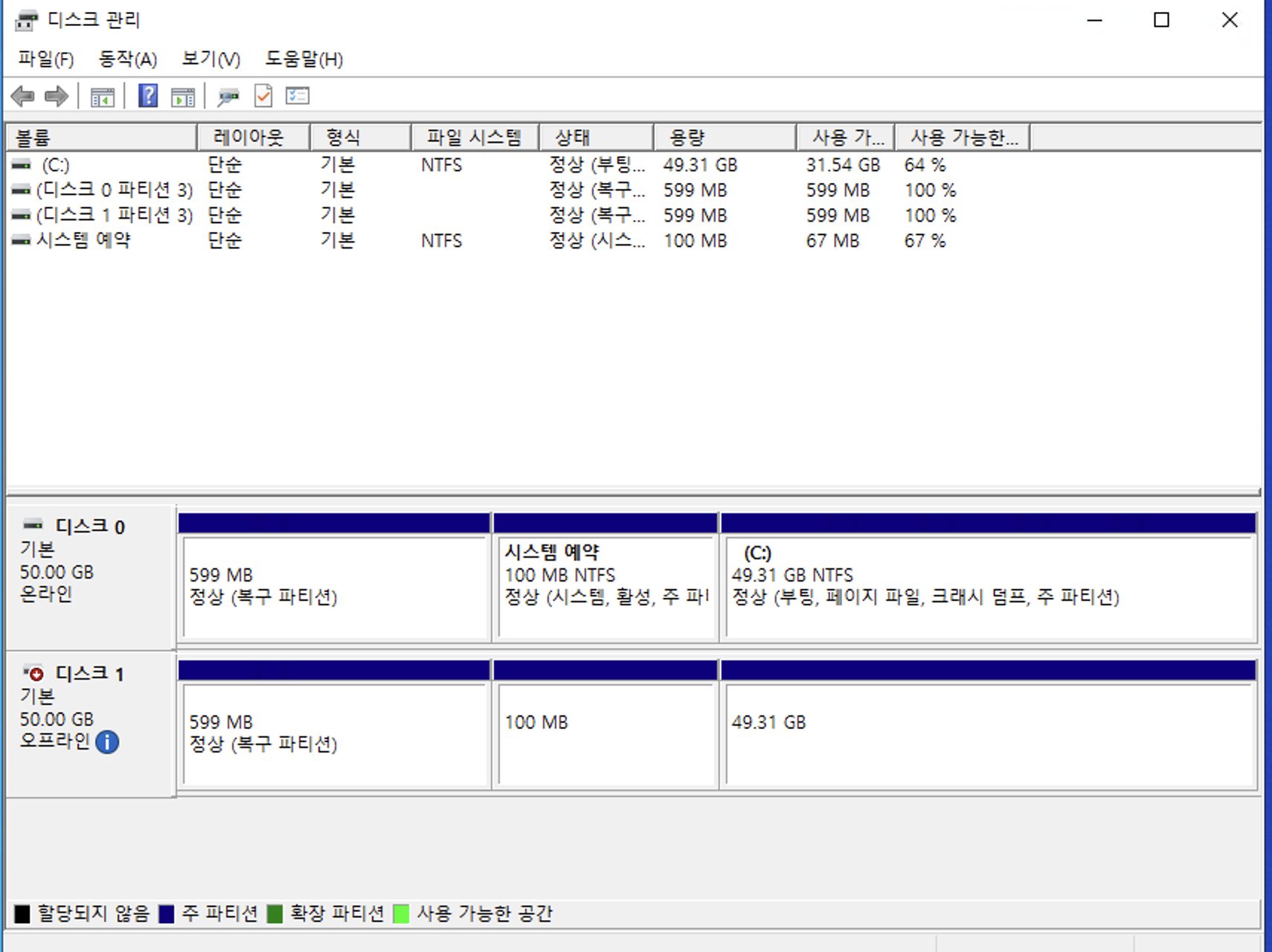
-
If the volume is recognized, bring it online.
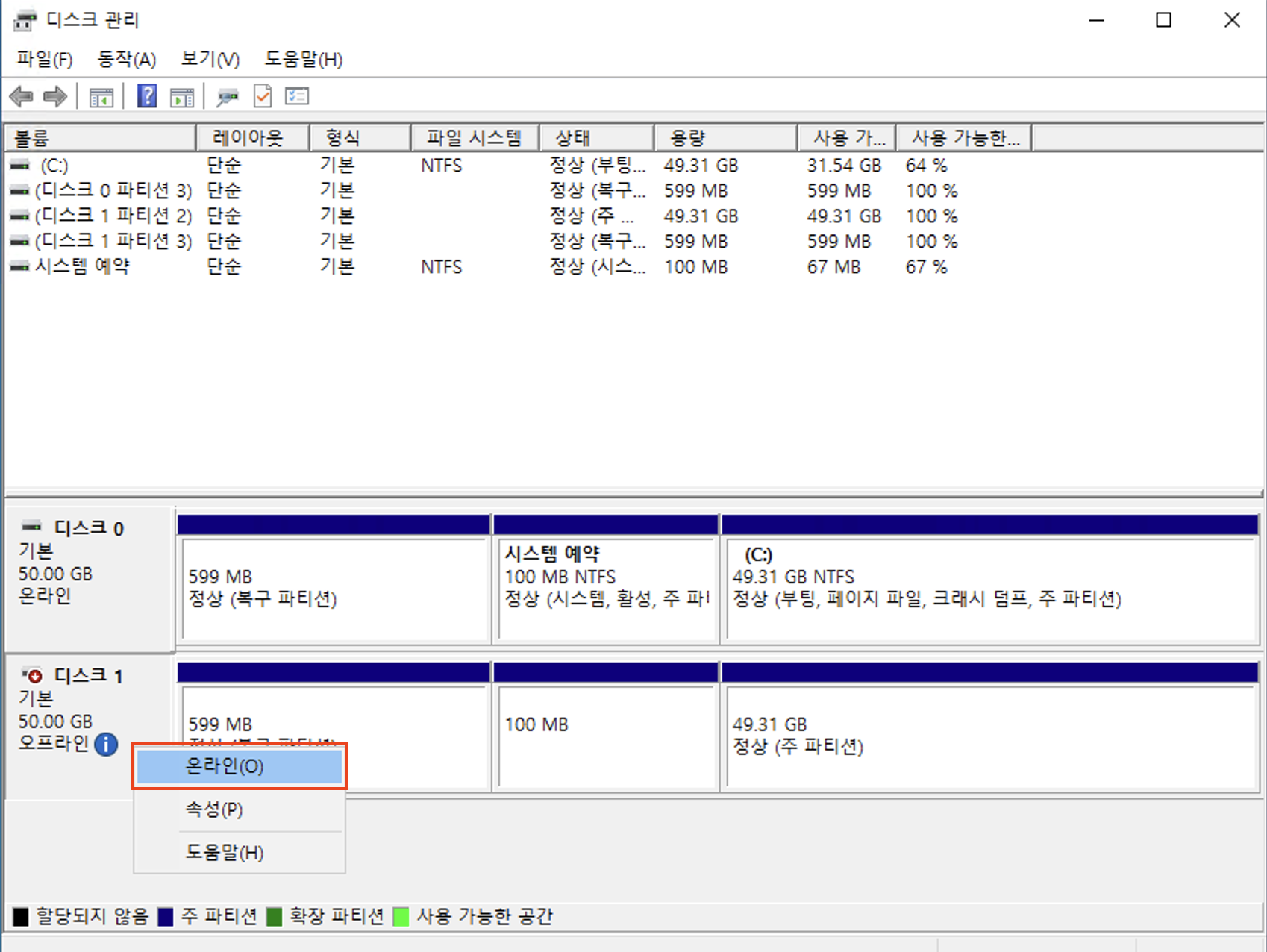
-
Confirm the mount point of the attached volume:
- It is assumed the recovery data resides on the system partition.
- Identify the mount path of that partition.
- In the example image, it is mounted at drive E:
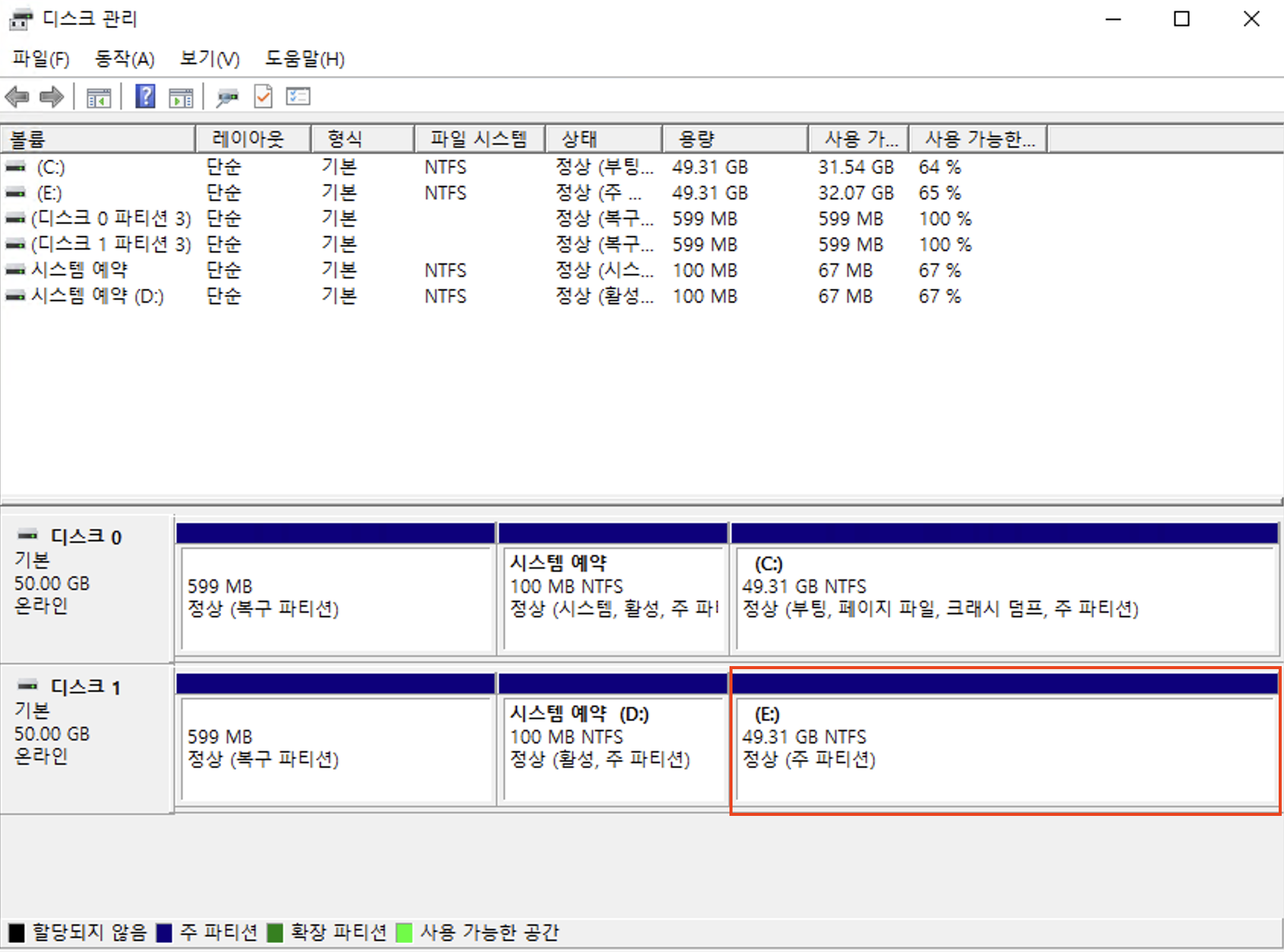
-
Open File Explorer to verify that the volume is properly mounted.

Step 6. Restore data from the mounted volume
- Go to the source and target directories in File Explorer.
- Restore the data using Copy and Paste (Drag & Drop).
Step 7. Detach the volume
-
Set the attached disk to offline.
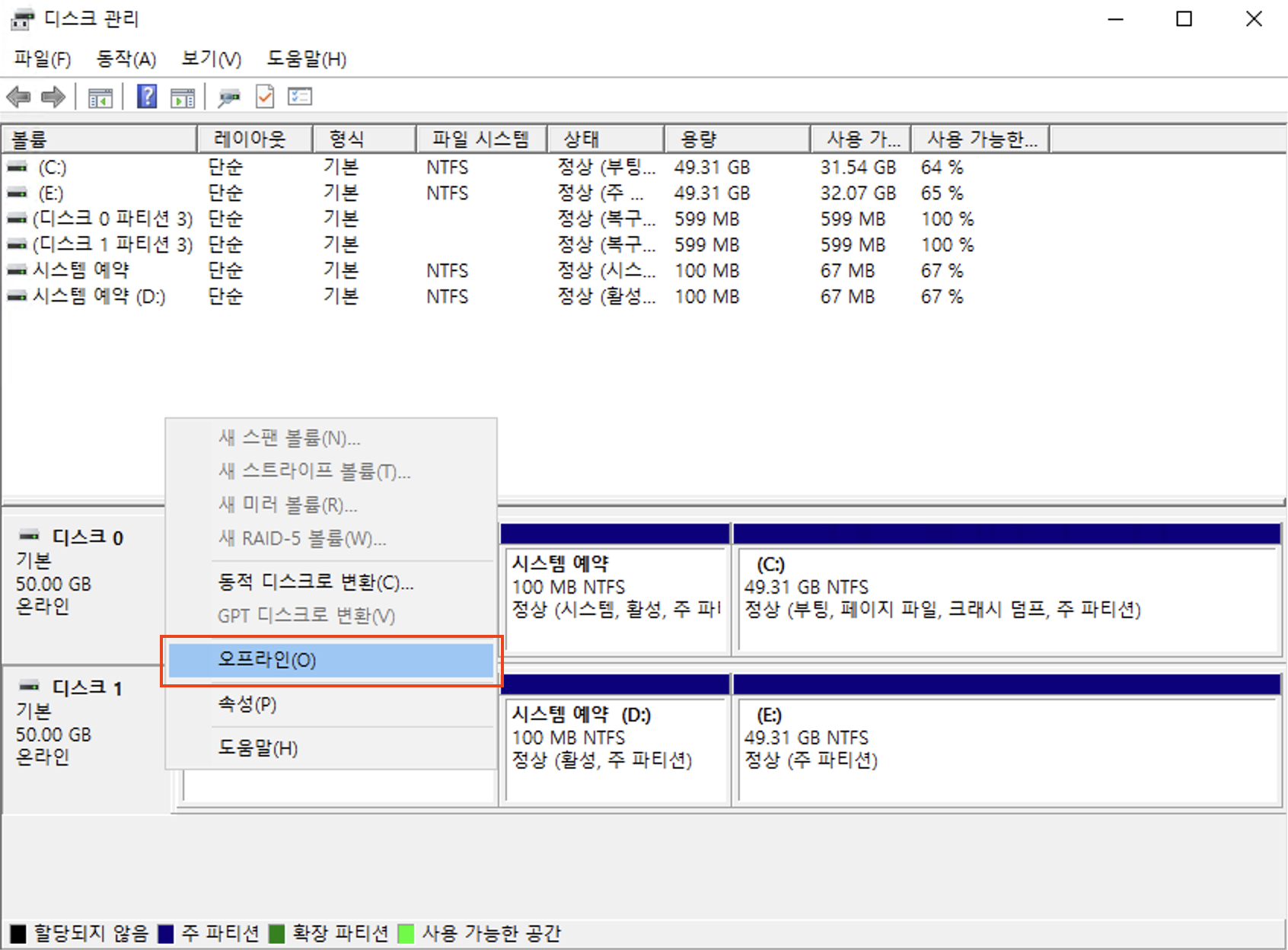
-
Follow the Detach volume document to remove the recovered volume from the console.
Restore data on an active instance
You can restore data by attaching the volume to an existing instance.
Restoring from a snapshot is useful when an instance fails to boot or the service becomes unresponsive, making SSH or RDP access impossible.
Step 1. Create a volume from the snapshot containing the data to restore
Refer to the Restore volume from snapshot tab document to create a volume from the required snapshot.
Step 2. Attach the volume to the instance requiring data recovery
Refer to the Attach volume from console document to attach the created volume to your instance.
- Linux
- Windows
Step 3. Mount the attached volume on the instance
-
Refer to the Connect to Linux instance guide to access the Linux instance to which the volume is attached.
-
Check the attached volume.
Check device connectionlsblkOutputNAME MAJ:MIN RM SIZE RO TYPE MOUNTPOINTS
vda 253:0 0 10G 0 disk
├─vda1 253:1 0 9G 0 part /
├─vda14 253:14 0 4M 0 part
├─vda15 253:15 0 106M 0 part /boot/efi
└─vda16 259:0 0 913M 0 part /boot
vdb 253:16 0 10G 0 disk -
Check which file system is used on the attached volume.
- Check file system type (ext4)
- Check file system type (xfs)
Check file system type (ext4)sudo file -s /dev/vdbOutput/dev/vdb: Linux rev 1.0 ext4 filesystem data, UUID=a69a34bb-e2fd-4e61-bf93-d462c4438730 (extents) (64bit) (large files) (huge files)Check file system type (xfs)sudo file -s /dev/vdbOutput/dev/vdb: SGI XFS filesystem data (blksz 4096, inosz 512, v2 dirs) -
Check the data integrity of the attached volume. Run the appropriate command for the file system in use and review the result.
- Check data integrity (ext4)
- Check data integrity (xfs)
Check data integrity (ext4)sudo fsck -n /dev/vdbOutput (ext4)fsck from util-linux 2.39.3
e2fsck 1.47.0 (5-Feb-2023)
/dev/vdb: clean, 11/655360 files, 66753/2621440 blocksCheck data integrity (xfs)sudo xfs_repair -n /dev/vdbOutputPhase 1 - find and verify superblock...
Phase 2 - using internal log
- zero log...
- scan filesystem freespace and inode maps...
- found root inode chunk
...
Phase 7 - verify link counts...
No modify flag set, skipping filesystem flush and exiting. -
Create a directory where the volume will be mounted.
Create directorysudo mkdir -p /mnt/restore -
Mount the volume to the created directory in read-only mode, as it contains backup data.
Mount command (directory and volume, read-only) (ext4)sudo mount -o ro -t ext4 /dev/vdb /mnt/restoreMount command (directory and volume, read-only) (xfs)sudo mount -o ro -t xfs /dev/vdb /mnt/restore -
Verify the volume is mounted properly.
Verify mountfindmnt /mnt/restoreOutputTARGET SOURCE FSTYPE OPTIONS
/mnt/restore /dev/vdb ext4 ro,relatime
Step 4. Restore required data from the mounted volume
-
Use the
rsynccommand to copy the data to the restore path (/path/to/restore).- The
--checksumoption can significantly increase processing time if a large amount of data needs to be restored, so use it only if necessary.
Copy datasudo rsync -avh --checksum /mnt/restore/ /path/to/restore/Resultsending incremental file list
backup-data-1
backup-data-2
sent 2.15G bytes received 55 bytes 330.46M bytes/sec
total size is 2.15G speedup is 1.00 - The
-
Verify the copied data:
ls -alh /path/to/restore/Sample outputtotal 2.1G
drwxr-xr-x 3 root root 4.0K Dec 10 07:24 .
drwxr-xr-x 3 root root 4.0K Dec 10 07:55 ..
-rw-r--r-- 1 root root 1.0G Dec 10 07:57 backup-data-1
-rw-r--r-- 1 root root 1.0G Dec 10 07:57 backup-data-2
Step 5. Unmount and detach the volume
-
Unmount the volume:
sudo umount /mnt/restore -
Refer to the Detach volume document to disconnect the volume from the instance using the console.
Step 3. Bring the attached volume online after accessing the instance
-
Refer to the Connect to Windows instance guide to access the newly created Windows instance.
-
Check the volume disk.
- Go to Start > Run or press the WIN + R shortcut key.
- In the Run window, enter
diskmgmt.mscand select OK or press Enter. - In Disk Management, locate the attached volume disk.
- Since the volume to be restored includes an OS, its partition structure may look similar to that of the OS volume mounted on the C drive.

-
If the volume is listed, bring it online.

-
Check the mount point path of the attached volume. In the image above, the volume is mounted on the (D:) drive.
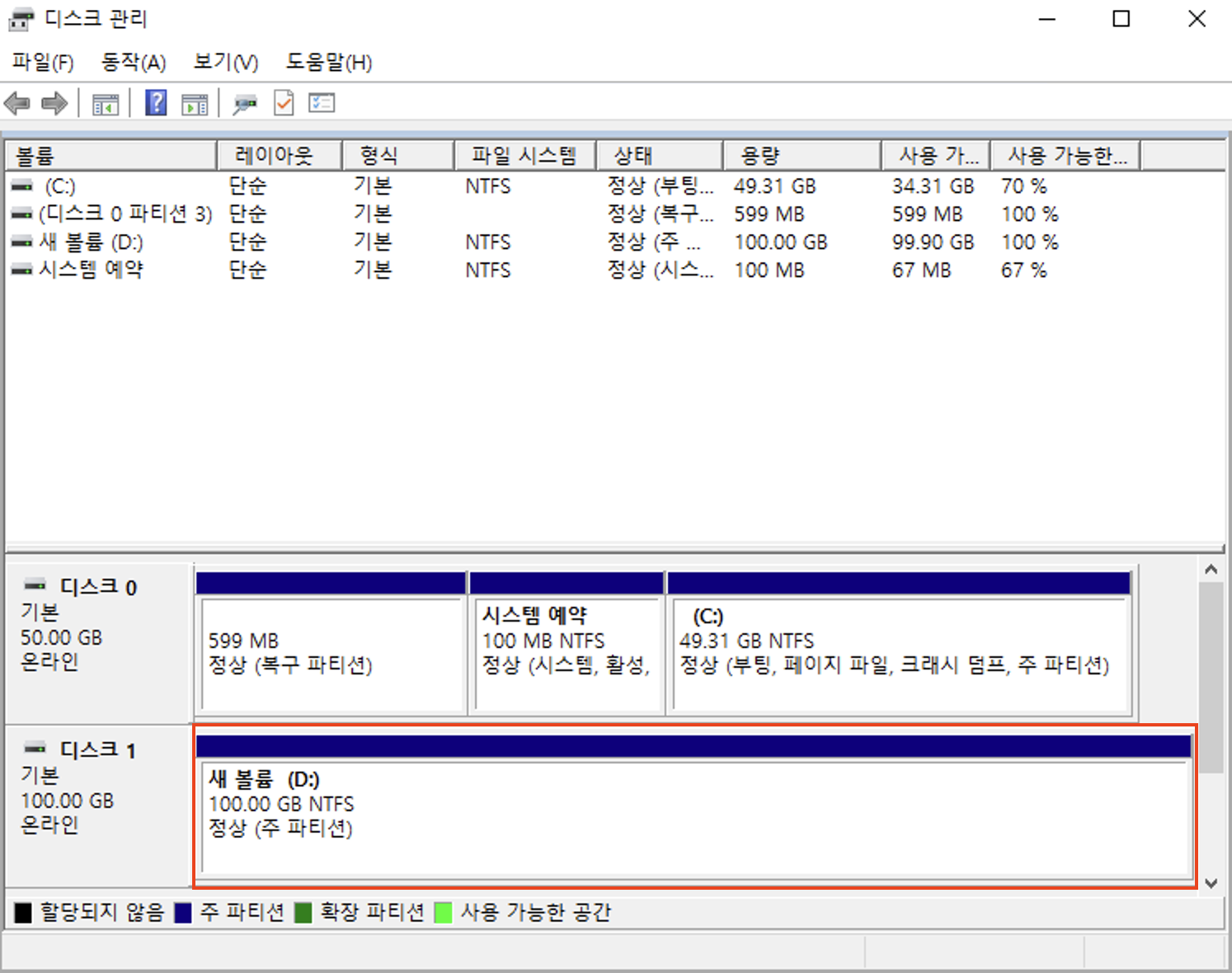
-
Open File Explorer

Step 4. Restore necessary data from the mounted volume
- Use File Explorer to browse the source and destination directories.
- Restore the data by copying and pasting it (Drag & Drop).
Step 5. Detach the connected volume
-
Change the connected disk status to Offline.
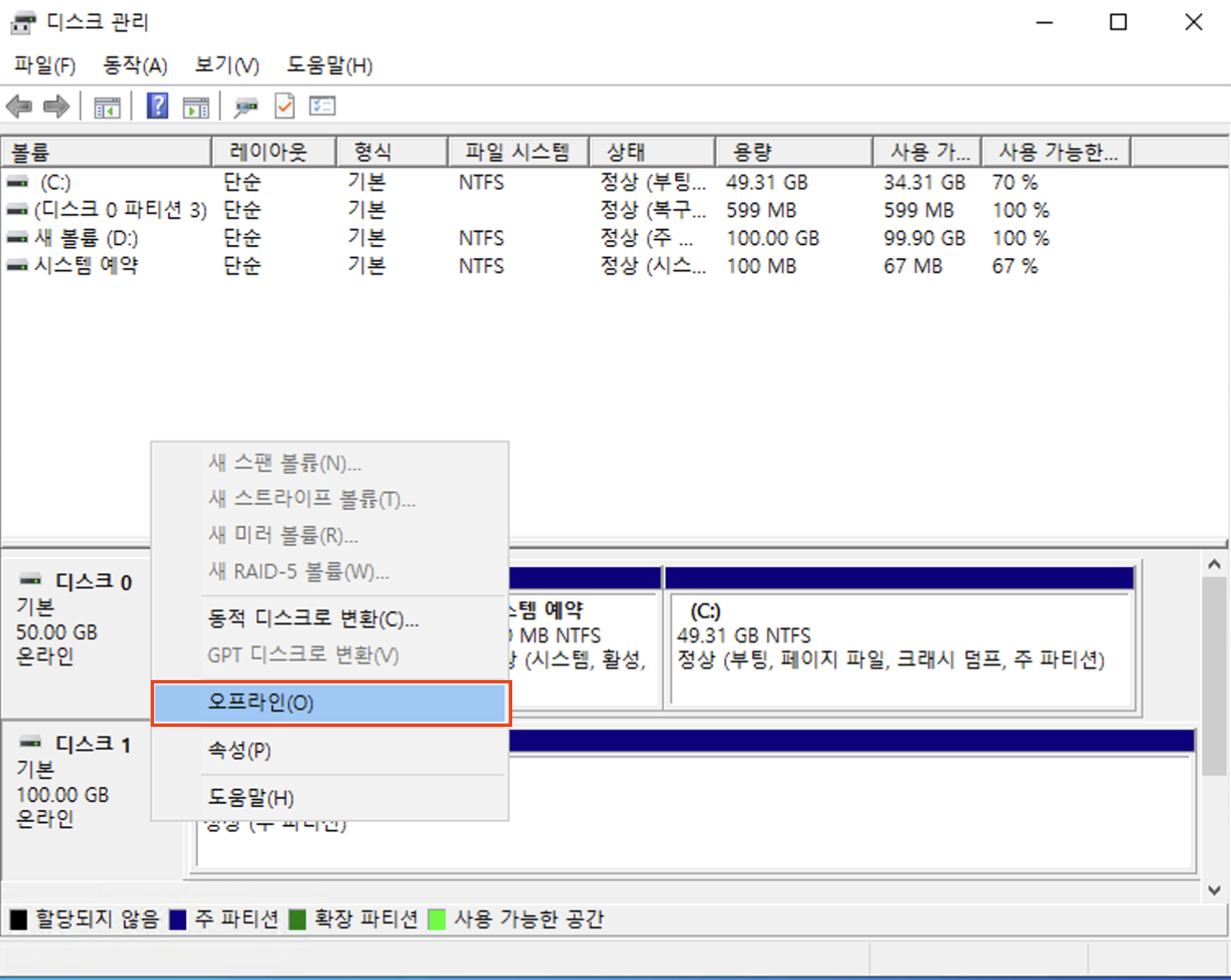
-
Refer to the Detach volume guide to detach the volume from the console after completing data recovery.
Make sure to detach the volume from the console after data recovery is complete.
Keeping the volume connected may cause data corruption, resource waste, or system conflicts.